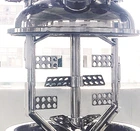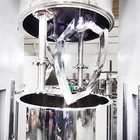Why the Double Planetary Mixer Is a Smart Investment for Your Production
Selecting the right mixing equipment can be a complex decision—especially when you're working with high-viscosity materials like adhesives, sealants, putties, or solder paste. Many mixers appear to offer similar capabilities at first glance, but subtle differences in function and design can have a significant impact on performance and product quality.
Among the available options, the Double Planetary Mixer (DPM) stands out for its versatility, performance, and adaptability, making it a smart long-term investment for many types of manufacturing environments.
However, before focusing on the DPM and its adaptability, we will first examine two other machines: the Solder Paste Mixer and the Sigma Kneaders & Multi-Shaft Mixers. This will give you all the information needed to make an informed choice based on their features and a clearer understanding of their differences.
Mixers for High-Viscosity Materials: What Are the Options?
Several mixer types are commonly used for thick or dense materials. Each comes with its own strengths, limitations, and best-use scenarios. Here's a closer look:
Double Planetary Mixer (DPM)
The DPM is widely used across several industries—from cosmetic creams and thick gels to adhesives and sealants, thermal pastes, putties, silicone compounds, and even solder paste (with some adaptations). It offers general-purpose functionality with high-quality results.
Strengths
- Ideal for high-viscosity, sticky, or dough-like materials
- Dual blades rotate and orbit for uniform, air-free mixing
- Can include vacuum and temperature control
- Adaptable for various materials and industries
Limitations
- Not suitable for ultra-high shear dispersion
- Custom blades may be needed for some applications
- Slightly slower than high-speed dispersers
Solder Paste Mixer (SPM)
The SPM is more limited in scope, typically used for SMT (Surface Mount Technology) production and reconditioning of solder paste. Nonetheless, it remains a highly specialized machine that delivers excellent results for that field.
Strengths
- Specially designed for solder paste
- Gentle mixing preserves solder sphere integrity
- Often includes de-airing and container rotation
Limitations
- Limited to specific paste types and containers
- Less versatile for other materials
- Typically used for small batches
Sigma Kneaders & Multi-Shaft Mixers
These machines are excellent for high-viscosity products such as rubber and elastomer compounds, resin-based adhesives, and heavy putties.
Strengths
- Very high shear and torque
- Suitable for dense, rubbery, or solid-filled materials
- Strong mechanical blending power
Limitations
- Difficult to clean
- Bulky and less flexible
- Limited to batch operations
- Slower discharge times
As we've seen, all three machines deliver high-quality results. However, unless you're focused on a specific product type, the Sigma Mixer and the SPM may be too specialized or cumbersome. If you're looking for a multipurpose solution, the DPM may offer the most flexibility. But can it truly replace the others in practice?
Adapting a DPM for Solder Paste and Similar Materials
Many clients looking for a solder paste mixer are surprised to learn that a DPM—though not originally designed for this use—can be successfully adapted with the right configuration.
- Blade geometry can be customized for gentle, low-shear mixing
- Speed controls allow precise mixing without damaging solder particles
- Vacuum capability helps eliminate trapped air and avoid voids
- Custom containers can hold syringes or jars securely for batch mixing
This makes the DPM not just a substitute, but a smarter, future-ready solution—especially for clients planning to diversify their product lines.
DPM vs. Sigma Kneaders and Multi-Shaft Mixers: Do You Really Need All Three?
If you're working with a wide variety of dense, thermal-sensitive, or high-shear materials, you might assume that you need multiple types of mixers. But in many cases, a well-configured Double Planetary Mixer can handle the work of a Sigma Kneader or Multi-Shaft Mixer—and more.
To replicate Sigma Kneader functionality:
- Use heavy-duty kneading blades such as spiral or rectangular designs
- Increase torque capacity to manage stiff or dense materials
- Add a jacketed mixing vessel for heating, if needed
- Include a tilting mechanism or discharge screw for easier removal
To replicate Multi-Shaft Mixer performance:
- Integrate a high-speed disperser or side scraper blades
- Add a central agitator or anchor, with customized shaft options
- Use temperature control jackets for thermal-sensitive applications
- Include vacuum and defoaming systems
These upgrades are mechanical and modular. A good DPM design can be customized accordingly. Instead of investing in multiple machines, many manufacturers choose a DPM to streamline operations, reduce maintenance, and save space—without compromising performance.
The DPM is one of the most versatile mixing systems. Depending on your application, it can effectively handle materials typically processed in a Sigma Kneader or Multi-Shaft Mixer, especially in medium- to high-viscosity ranges. However, for extremely heavy-duty shear processing or continuous mixing, it may not be the ideal substitute.
Cost Comparison and Investment Value
When considering which mixer to invest in, cost is always a major factor—not just the initial purchase price, but also operational expenses, maintenance, and long-term versatility. Here's how the three mixer types compare:
|
Mixer Type |
Initial Cost |
Operating Costs |
Maintenance |
|
Double Planetary Mixer |
Moderate |
Moderate (multi-use) |
Easy to clean, low wear |
|
Solder Paste Mixer |
Low–Moderate |
Low (small batches only) |
Minimal upkeep |
|
Sigma Kneader / Multi-Shaft |
High |
High (energy and labor) |
Difficult to clean, bulky systems |
Long-Term Investment Value
Double Planetary Mixer (DPM):
The DPM offers unmatched versatility and scalability, making it ideal for manufacturers producing a variety of high-viscosity products. With proper configuration, it can adapt to a wide range of materials, eliminating the need for multiple machines. This flexibility translates to long-term savings, easier maintenance, and faster return on investment. For growing or diversifying operations, the DPM is a future-proof choice.
Solder Paste Mixer (SPM):
While SPMs are effective within a narrow scope, their limited functionality makes them more of a short-term solution. They're a strong fit if you only ever work with solder paste, but if your production needs evolve, you'll likely require additional equipment. Long-term, SPMs may result in added costs to support broader manufacturing goals.
Sigma Kneaders / Multi-Shaft Mixers:
These machines provide powerful torque and shear for the most demanding materials, but they often come with high operational costs, long cleaning times, and space limitations. While valuable in certain niches, their long-term benefit is limited unless used consistently at full capacity.
Why DPM Is a Cost-Effective Choice
- One machine for many functions: Instead of investing in separate mixers for different applications, one well-configured DPM can cover a wide range.
- Lower maintenance costs: DPMs are easier to clean and maintain than kneaders or multi-shaft mixers.
- Scalable: Available from small lab models to full industrial production units.
- Future-ready: Easily adapts as your product range grows, supporting long-term operational needs.
Final Thoughts: The Long-Term Value of a Double Planetary Mixer
Specialized equipment like solder paste mixers may seem like the perfect fit for a single task, but they often lack the flexibility required in modern production environments. The Double Planetary Mixer delivers consistent performance across a wide range of materials and processes, making it a cost-effective and scalable investment for your facility.
While specialized machines may appear to offer savings in the short term, they can limit your adaptability and require further investment down the road. A Double Planetary Mixer, on the other hand, may involve a moderate initial cost, but offers significant long-term value through lower maintenance, broader usability, and adaptability—making it a strategic choice for facilities aiming to grow or diversify.
If your supplier doesn’t offer the exact machine you had in mind, consider asking about a DPM. With the right configuration and support, it may meet or even exceed your expectations.














































































































